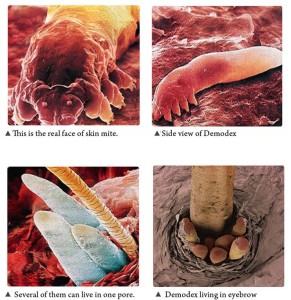Mites

Mighty Mites
They hide in your bed and breed on your face. They’re smaller than the period at the end of this sentence.
By Rob Dunn
Photographs by Martin Oeggerli
Read More


By Rob Dunn
Photographs by Martin Oeggerli
Read More
Hot, humid areas of the world have more of everything, including insects and diseases.
They also have, must have, devised way to be either immune to them, or have a working daily regimen that somewhat protects them.
Hot, spicy food is one of them. They don’t eat it because they like it, they like it because they eat it…
Hot spices, like hot hot hot peppers, create an internal environment, that is not friendly to critters of any kind, because it kills them.
The situation, unfortunately, is different with critters on your skin, eyes, nose, ears, even your mouth… they require different protection.
In this fight to reclaim our bodies from the invading armies of mites, we need to find or devise methods to make our skin etc. uninhabitable for mites of any kind.
70% of people in India have mites. All kinds of mites. They have ways to deal with just one of them: scabies: Operation Dunking.
The rest of the world hovers around 20-30%.
Temperate climates like the United States are unprepared to deal with the load… no hot foods, no natural enemies, too many taboos… too frequent showering, too much emphasis on how someone looks, sleepwalking… Americans are food for the mites… they can take this country without any resistance.
When I offer resistance, I, as a true empath, can feel their emotions: first surprise, then anger and fury.
I’m a 67 year old woman.
I’ve had to live with sometimes unbearable itching, with doctors staring at my female parts under strong surgical lights, 3 surgeries …
The reason is that there is an undetected epidemic of biting spider mites that reproduce in the vaginal canal (and also in the anus) and when they are born, they bite, and they itch … I mean ITCH!
But if itchiness were the most awful thing they do, I probably would not be publishing this blog.
Read More
Spider mites are tiny, and have an unusual (in developed countries, that is) way to go through the four stages of an insect life cycle:
The adult spider mite lays eggs inside the nose of a warm blooded mammal, and then the eggs get into the digestive tract, and go through two more phases, two more stages of the cycle. They come out hungry nymphs that are ready to molt into fully developed spider mites, just need a little help from the host: skin juices.
If this makes your stomach turn: yeah, it turns my stomach too. And makes me feel violated, abused, and all the horrid feelings we so try to avoid, and here it is.
Because of this unusual habit, doctors, it seems haven’t discovered that a large segment of the population is host and nursery for these parasitic creatures.
My guess is, supported by my own muscle testing, is the Morgellons, the condition that drives people crazy and to suicide, is simply (sounds ridiculous, but it is in fact more simple that the descriptions other give to Morgellons) spider mite infestation.
Become a member to read the rest of the article and find the solutions missing on other mites sites
If you don’t want to go to the membership area, then enjoy this video
Muscle testing shows that Morgellons ((This article is from WebMD:
Morgellons
In this article
Symptoms of Morgellons
Treatment of Morgellons
Who Gets Morgellons
The Debate Over Morgellons
Morgellons is a controversial and poorly understood condition in which unusual thread-like fibers appear under the skin. The patient may feel like something is crawling, biting, or stinging all over.
Some medical experts say Morgellons is a physical illness. Others suggest it is a type of psychosis called “delusional parasitosis,” in which a person thinks parasites have infected their skin.
Your doctor may call it an “unexplained dermopathy,” which means a skin condition that occurs without a known reason. Other medical professionals have dubbed the condition “fiber disease.”
Symptoms of Morgellons
Unpleasant skin sensations are the main complaint. People with Morgellons may also complain of:
Feeling like bugs are crawling all over the skin.
Burning or stinging sensations under the skin.
Intense itching.
Skin sores that appear suddenly and heal slowly.
Sores that leave very red (hyperpigmented) scars.
Some patients report thread-like fibers stuck in the skin.
People with Morgellons sometimes complain of other symptoms which may include:
Difficulty paying attention and concentrating
Extreme fatigue
Hair loss
Joint and muscle pain
Nervous system problems
Tooth loss
Sleep problems
Short-term memory loss
Treatment of Morgellons
There is no known cure for Morgellons. Treating any medical or psychiatric problems that occur at the same time as Morgellons may help ease Morgellons symptoms in some patients.
A team of medical researchers at the Mayo Clinic also recommend that patients with these symptoms should undergo psychiatric evaluation.
Who Gets Morgellons
In the past, few doctors had heard of Morgellons. But in response to scattered reports, the CDC worked together with several other health care agencies to investigate this condition. Most reports came from California, Texas, and Florida, although patients have been seen in all 50 states.
The CDC study found that Morgellons is most likely to affect middle-aged white women.
Many of the patients in the CDC study showed signs of being obsessively concerned about health problems in general. This is called somatic concerns.
About half of the people in the study had other health problems, including depression and drug abuse.
The Debate Over Morgellons
The question of whether Morgellons is a disease or a delusion has prompted debate and new research in recent years.
The CDC states that the condition is not caused by an infection or anything in the environment.
The CDC study also included a lab analysis of skin fibers in Morgellons patients. The analysis showed that these fibers were mostly cotton, such as typically found in clothing or bandages.
CDC research also revealed that the skin sores seemed to be the result of long-term picking and scratching the skin.
The CDC report goes on to say: “We were not able to conclude, based on this study, whether this unexplained dermopathy represents a new condition, as has been proposed by those who use the term Morgellons, or wider recognition of an existing condition such as delusional parasitosis.”
The results of the CDC study have been archived and are no longer updated. The CDC does not plan to do any further research on the matter.
Besides the CDC, other research teams have contributed to the debate on Morgellons.
Previous case studies and research have suggested that Morgellons may be linked to Lyme disease. Some patients with signs and symptoms of Morgellons had tested positive for the bacteria that causes Lyme disease.
But according to Morgellons researchers at Oklahoma State University, there is no evidence to prove this theory. Likewise, there was no evidence of Lyme infection in any of the people in the CDC study.
A 2010 study found a potential link between Morgellons symptoms and an underactive thyroid (hypothyroidism). More research needs to be done to further investigate this finding.
Morgellons also appears similar to a condition seen in cattle called bovine digital dermatitis, which is due to an infection, according to a 2011 study. But no conclusions can be reached from these small studies.)) is a spider mite infestation.
I know, the mystery is much more interesting, but what if that’s all that is. Being infested with spider mites that inoculate you with their eggs, the eggs develop into nymphs, the nymphs come out of your anus or sometimes your vagina, and need to still feed on you, so they bite you.
The spider mites consider you food… and attempt to immobilize you with spider web…
The mites are tiny, and the fiber like spider web pieces are tiny too.
What none of the researchers did, none of the doctors, not the CDC is actually observe.
Continue reading at the membership site. You have to be a paid member to see this material
What you think is bacterial vaginosis, yeast infection, or trichomonas… may be “only” a spider mite infestation, or a combination of all the above.
One symptom, the intense itching, is what makes these vastly different conditions feel like the same. I’ve been there, I’ve done it.
So, how can you tell if you have an infection or an infestation?
Read More
My heart almost stopped…
I felt something climbing up my shirt. I have been wearing no bra for the past 10 days or so, and loose shirts so I can catch a critter before it bites… some bites are really nasty and don’t want to heal.
So I reached there, and there it was, greenish spider mite, an adult specimen. Of course I had nothing to put it into, so I killed it, but now I am totally restless, it feels like hundreds are crawling on me… the mind is a very interesting equipment.
Part 2: I decided to not let the situation keep me up any longer, I haven’t slept much for the past five nights, so mind over matter… I’ll sleep.
That was both a big mistake and a big blessing. I did wake up, but by that time I had 10 nymphs bitten me, causing pimple-like phenomenon… now you know where those things come from that look like a pimple, but they are hardened skin. Spider mite bites.
I know a guy who used to get these bites that wouldn’t heal. A bite with a tiny black speck giving away the fact that something was living inside… He got these on his neck, on his chin, and they would itch tremendously. Where else he had them, he didn’t say.
He asked me to treat them with MMS, that claims to eradicate all pests… bah humbug. The MMS burned a hole in his face, his neck.
He used to take long baths in his friend’s seawater pool, and that would help with the itching, but didn’t do much for the whole issue: bites and new bites with little black speck in the middle.
He hasn’t complained for some time now, so I thought to ask him what happened.
Read More

 Rosacea is not an infectious disease, and there is no evidence that it can be spread by direct contact with the skin of an affected patient or through inhaling airborne bacteria. However, there has long been a theory that parasites within the sebaceous follicles of the face can stimulate inflammation.
Rosacea is not an infectious disease, and there is no evidence that it can be spread by direct contact with the skin of an affected patient or through inhaling airborne bacteria. However, there has long been a theory that parasites within the sebaceous follicles of the face can stimulate inflammation.
Read More
It started seven months ago. I accidentally discovered that I have mites living in my ears.
I searched the web and did what I found. I followed instructions. Nothing worked… At that point I had no idea that they live all over me… Until I did.
My insomnia suddenly started to make sense… the crawling sensation on my body, on my head, on my face… it was real, and I was in trouble.
It took me a few more months before I discovered that there are billions of people like me… and many of them have made their struggle public…
Read More